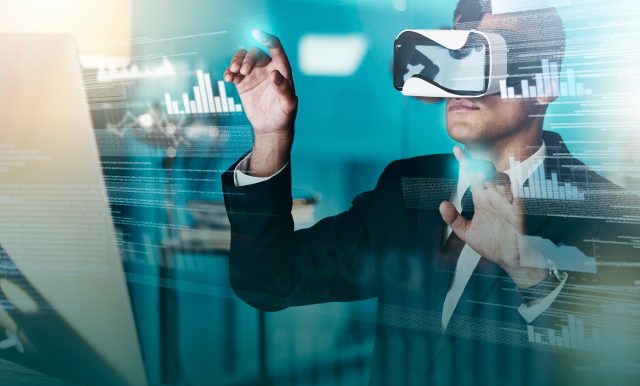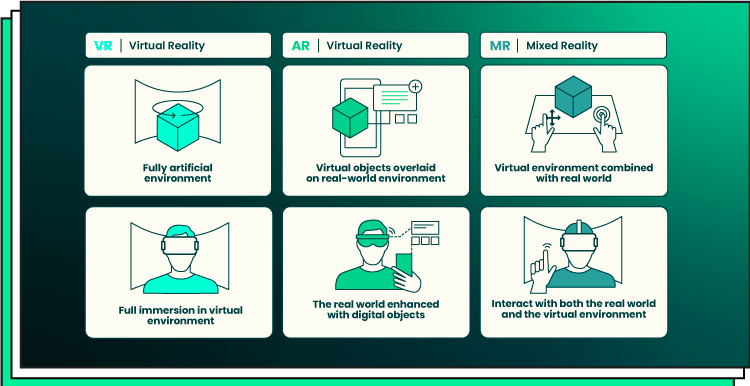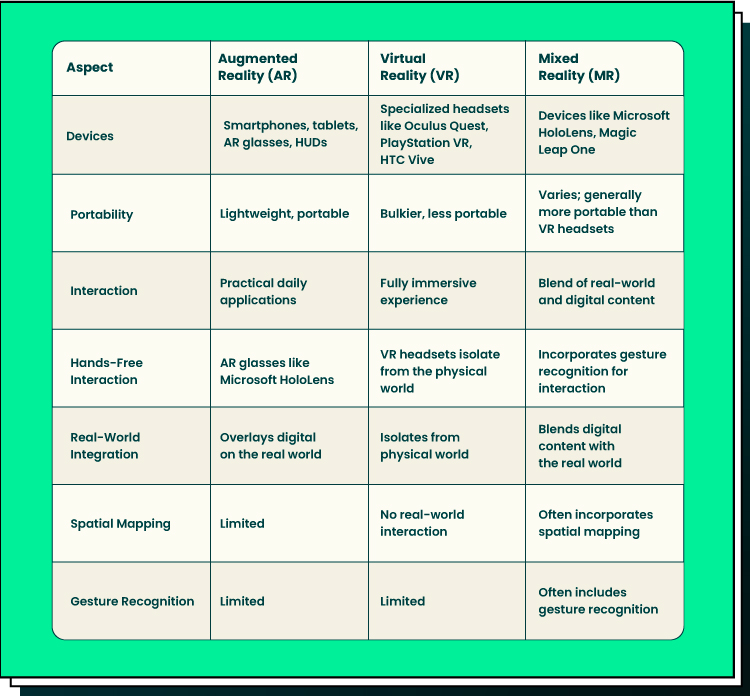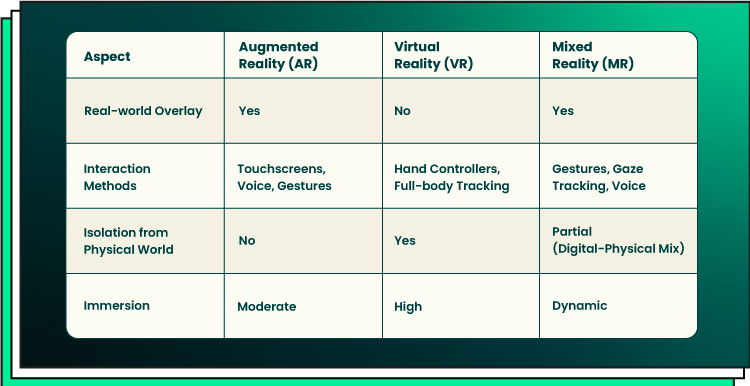Distinguishing between Augmented Reality (AR) and Mixed Reality (MR) isn’t just a choice but a strategic necessity for business owners. Consider the numbers: Over 1.2 billion AR-ready smartphones worldwide in 2023. Customers are not only embracing AR/VR/MR capabilities, but they’re also relying on it for making informed purchase decisions. For instance, 56% of surveyed shoppers, according to NielsenIQ, express heightened product confidence through AR, and a significant 61% actively prefer retailers offering AR experiences.
Worldwide spending on augmented reality and virtual reality (AR/VR) is poised to surge from $13.8 billion this year to an astounding $50.9 billion by 2026, as projected by the International Data Corporation. This meteoric growth underscores the urgency for businesses to decipher the unique potentials of AR and MR. As the immersive technology narrative unfolds, this exploration equips business owners with the insights they need to seize the opportunities within the AR vs. MR landscape.
Introduction to AR, VR, and MR: Comparing Augmented Reality vs. Mixed Reality (AR vs. MR)
Understanding the nuances of Augmented Reality (AR), Virtual Reality (VR), and Mixed Reality (MR) becomes essential when exploring how these technologies are shaping our world. In particular, the comparison between augmented reality vs. mixed reality (AR vs. MR) and MR vs. AR is a topic of interest.
The distinctions matter as they impact industries, from gaming to education, and guide decisions about technology adoption. As AR and MR continue to evolve and converge, staying informed about their unique features is key to harnessing their potential effectively. This article delves into the motivations behind comparing AR, VR, and MR, shedding light on the transformative power of these immersive technologies.
Augmented Reality: bridging realities
AR refers to technology that overlays digital content in the real world. It enhances the user’s perception of the physical environment by adding computer-generated information. AR is often experienced through smartphones, tablets, smart glasses, or heads-up displays (HUDs).
Augmented Reality (AR) has rapidly evolved into a game-changer, merging digital and physical realms. In the 1990s, AR’s journey began when Boeing’s Tom Caudell coined the term. The 2010s saw AR go mainstream, notably with Pokémon Go. Today, AR is transforming industries. It aids surgeons, enriches modern electronic education methods, and engages consumers through interactive marketing.
The future of AR is exciting: Sleek AR glasses are on the horizon, set to become a part of daily life. As 5G networks expand, AR’s potential grows. It will be a vital player in the emerging metaverse, offering immersive experiences in connected virtual worlds.
Virtual Reality (VR)
VR immerses users entirely in a digital environment, disconnecting them from the physical world.
- It is typically experienced through headsets that cover the user’s eyes and ears.
- VR applications range from gaming/entertainment and simulations to virtual tours and training.
Virtual Reality (VR) has its roots in the mid-20th century when visionaries like Morton Heilig and Ivan Sutherland began conceptualizing immersive experiences. Heilig’s Sensorama in the 1950s offered multisensory engagement, while Sutherland’s “Sword of Damocles” in the 1960s introduced the first head-mounted display (HMD).
The term “Virtual Reality” gained traction in the 1990s, thanks to Jaron Lanier and his company, VPL Research. Early VR was rudimentary but laid the groundwork for today’s immersive experiences. In recent years, VR has surged in popularity, becoming accessible and versatile across gaming, education, and industry, with brands like Oculus, Sony, and HTC leading the way.
Mixed Reality (MR)
MR is a technology that blends the physical and digital worlds, allowing interaction between the two.
- It enables digital objects to coexist with physical surroundings and interact with them.
- MR devices like Microsoft HoloLens provide a seamless fusion of real and virtual elements.
- MR serves as a game-changer in industrial design, facilitating interactive 3D modeling.
For example, Mixed Reality (MR) can be used for managing devices via virtual immersive 3D interfaces. MR technology allows for the creation of interactive, 3D interfaces that can be overlaid onto physical devices or objects. These interfaces provide users with a more intuitive and immersive way to control and manage devices and vehicles, including drones.
Comparing AR, VR, and MR Hardware
Augmented Reality (AR) encompasses everyday gadgets like smartphones, tablets, AR glasses such as Lenovo ThinkReality A3 or Vuzix m400, and Heads-Up Displays (HUDs). These portable, lightweight tools have seamlessly integrated into our daily lives, enhancing practical applications. Notably, AR glasses like the Microsoft HoloLens elevate the experience, enabling hands-free interaction with digital content.
On the opposite end of the spectrum lies Virtual Reality (VR), which relies on specialized headsets such as the Oculus Quest series, PlayStation VR, and HTC Vive. These headsets transport users into entirely digital realms, captivating them with high-fidelity visuals and immersive audio. However, the bulkiness of VR headsets and their detachment from the physical world often limit their everyday utility, reserved primarily for dedicated immersive experiences.
Mixed Reality (MR) emerges as the bridge between AR and VR, exemplified by devices like the Microsoft HoloLens and Magic Leap One. MR devices empower users with the unique ability to seamlessly merge both the real world and digital content. In MR, digital objects come alive in real-world contexts. MR headsets often boast advanced features, including gesture recognition and spatial mapping, elevating the user experience and rendering them suitable for a vast array of tasks.
Augmented Reality (AR)
- AR devices include smartphones, tablets, AR glasses (e.g., Google Glass), and HUDs.
- These devices are lightweight, portable, and often used for practical daily applications.
- AR glasses like the Microsoft HoloLens offer hands-free interaction with digital content.
Virtual Reality (VR)
- VR requires specialized headsets like Oculus Quest, PlayStation VR, and HTC Vive.
- VR headsets provide a fully immersive experience with high-quality visuals and audio.
- They are bulkier and less suitable for everyday use due to their isolation from the physical world.
Mixed Reality (MR)
- MR devices like the Microsoft HoloLens and Magic Leap One blend AR and VR capabilities.
- Users can see both the real world and digital content, making them suitable for various tasks.
- MR headsets often incorporate gesture recognition and spatial mapping for interaction.
User Experiences and Interaction Methods
Augmented Reality (AR)
In the realm of user experiences and interaction methods, Augmented Reality (AR) brings a unique blend of digital augmentation to the real world. AR offers an overlay of digital information onto the user’s real-world view, enriching their perception and interaction. Here’s how AR users engage with this immersive technology:
- Interaction. AR interfaces are often touch-driven, with touchscreens on smartphones or tablets being common platforms. Users can directly manipulate digital content with their fingertips, adding a tactile dimension to the experience. Voice commands and hand gestures are also frequently used to interact with AR content.
- Contextual awareness. One of AR’s defining features is its ability to provide contextual information. Users can access relevant details, such as location-based data or real-time translations, without losing sight of their surroundings. This seamless integration of digital and physical enhances the user’s awareness in many sectors. For example, AR perfectly works with modern retail businesses.
Virtual Reality (VR)
Virtual Reality (VR) takes users on a journey into fully immersive digital environments, effectively blocking out the physical world. VR offers distinct interaction methods that transport users to entirely new realities:
- Interaction. VR relies on specialized hand controllers or even full-body tracking suits. These devices allow users to interact with virtual objects and environments with precision. Users can use their hands to manipulate objects, navigate through virtual spaces, and engage in immersive storytelling experiences.
- Immersion. VR prioritizes immersion above all else. By isolating users from the physical world, VR creates a sense of presence in a digital environment. Visuals and audio are carefully designed to transport users, making them feel like they’ve stepped into another world. VR is largely associated with 3D entertainment projects and games.
Mixed Reality (MR)
Mixed Reality (MR) represents a dynamic fusion of AR and VR, offering users an intricate blend of physical and digital interactions. MR opens up a realm of possibilities in user experiences:
- Interaction. MR offers diverse interaction methods, including gestures, gaze tracking, and voice commands. Users can manipulate digital objects within their physical surroundings, combining the best of both worlds. This versatility allows for seamless interaction and control in different domains, including logistics and warehousing.
- Dual realities. In MR, users experience both the real world and digital content simultaneously. For instance, they can design 3D objects while seeing their real hands and environment. This dual-reality experience introduces a new level of versatility for various applications like composable e-commerce.
Comparison of user experiences and interaction methods:
Industry Applications and Success Stories: AR vs. AR vs. MR
Augmented Reality (AR) is a versatile and popular technology with a wide array of applications across various industries. Here are some notable sectors where AR has made a significant impact:
- Retail. AR is transforming the retail landscape (especially it referring to the e-tailing industry) by offering virtual try-ons for clothing and accessories, enabling product visualization in the real world, and providing location-based advertising to attract customers.
- Healthcare. Surgeons are leveraging AR for navigation assistance during complex surgeries, enhancing precision and reducing risks. AR apps also play a role in patient education, simplifying the explanation of medical procedures.
- Education. AR is revolutionizing education by introducing interactive textbooks and educational games that engage students in immersive learning experiences.
Virtual Reality (VR) is renowned for its ability to create immersive environments, leading to its adoption in several industries. Here are prominent applications and success stories for VR:
- Gaming. VR gaming experiences like Beat Saber and Half-Life: Alyx have gained immense popularity, offering players an unparalleled level of immersion and interactivity.
- Training. VR is an invaluable tool for training simulations in fields such as the military, aviation, medicine, and industrial sectors. It provides a safe and realistic environment for trainees to learn and practice.
- Therapy. VR therapy is proving effective in treating conditions like PTSD and phobias by exposing patients to controlled and immersive therapeutic scenarios.
Mixed Reality (MR) combines elements of both AR and VR, opening up unique possibilities in various industries. Here are examples of MR applications and success stories:
- Industrial design. MR plays a critical role in industrial design, allowing designers to interact with 3D models in real-time. It facilitates prototyping and enhances the creative process.
- Medical simulations. Surgeons use MR for medical simulations to practice complex procedures with a blend of digital and physical elements. This improves surgical precision and reduces errors.
- Maintenance and repair. Technicians benefit from MR’s real-time guidance while working on intricate machinery. MR overlays digital instructions onto physical equipment, aiding in maintenance and repair tasks.
Addressing Challenges and Maximizing Potential
While Augmented Reality (AR), Virtual Reality (VR), and Mixed Reality (MR) offer captivating possibilities, they are not without their hurdles. The challenge of a limited field of view has often restricted users’ experiences, particularly in navigation or gaming scenarios.
Privacy concerns loom as AR devices accumulate user data, raising questions about tracking and targeted advertising. Additionally, the need for more engaging AR content persists, hindering broader adoption. VR, on the other hand, can introduce motion sickness in users, especially during initial use, potentially deterring adoption. The high cost of top-tier VR hardware also poses a financial barrier for many potential users.
MR faces a technical challenge in achieving seamless integration between the physical and digital worlds. Precise tracking of the user’s movements and realigning digital content with the user’s perspective demand ongoing innovation. Yet, despite these challenges, AR, VR, and MR continue to evolve rapidly, promising groundbreaking applications across diverse industries.
- For AR, developers can create more compelling content, and AR device manufacturers can enhance the field of view and address privacy concerns.
- In the VR realm, manufacturers can work on cost reduction and motion sickness mitigation.
- MR device makers can focus on improving tracking accuracy and refining digital content alignment with the user’s perspective.
AR, VR, and MR Adoption & Market Trends
Augmented Reality (AR) has gained extensive traction, finding applications in gaming, marketing, and navigation. In 2021, the mobile AR market was valued at approximately $12.45 billion. Projections foresee robust growth, nearing $17 billion in 2022, and a substantial leap to over $36 billion by 2026. This dynamic market encompasses diverse facets, including in-app purchases, advertising, and cutting-edge visualization software.
Meanwhile, the VR Software sector anticipates reaching $3.34 billion in revenue for 2023, with an expected annual growth rate of 13.07% (CAGR 2023-2027). This trajectory is set to propel the market to $5.46 billion by 2027, with a significant contribution from the United States, expected to generate $831.60 million in revenue in 2023. Furthermore, user numbers in the VR Software sector are poised to reach 156.2 million by 2027.
AR/VR/MR Business and Enterprise Use Cases
In September 2022, Walmart enhanced its augmented reality (AR) capabilities, allowing customers to visualize how TVs would appear in their homes, presenting a tangible AR use case. This feature complements another AR addition from July 2022, emphasizing Walmart’s commitment to providing an engaging and convenient shopping experience. Customers can now seamlessly preview furniture, home décor items, and electronics in their spaces before making informed purchase decisions.
Boeing employs virtual reality (VR) on its factory floor for the production of the new 737 MAX 10 aircraft. Mechanics use VR to visualize the landing gear installation, providing early feedback on potential issues months before assembly begins. This hands-on VR experience enhances preparation and collaboration between mechanics and engineers, ensuring the aircraft’s efficiency and design.
The Final Word
AR, VR, and MR offer distinct immersive experiences with evolving applications across various industries. Understanding their unique attributes is vital in navigating this tech landscape. The future holds exciting possibilities as these technologies mature and converge, creating new realms of interaction. For guidance on adopting AR, VR, and MR capabilities, consider engaging Forbytes’ skilled engineers and developers to choose the best path for your needs.

Our Engineers
Can Help
Are you ready to discover all benefits of running a business in the digital era?

Our Engineers
Can Help
Are you ready to discover all benefits of running a business in the digital era?











